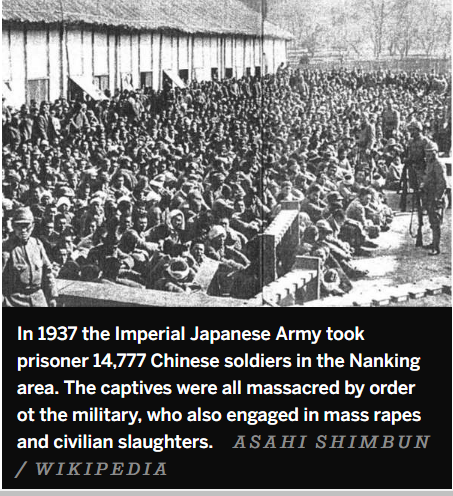Vancouver Sun 2016年10月22日(土)
Joy Kogawa urges facing Japanese war atrocities
Douglas Todd記者 dtodd@postmedia.com

1937年日本帝国陸軍は南京地区で中国人1万4千777人を捕虜にした。捕虜は日本軍の命令によって全員虐殺された。日本軍はまた集団強姦や市民の屠殺も行った。
朝日新聞 / WIKIPEDIA
**************************************************************************
Vancouver Sun 2016年2月28日(日)
Lest we forget the “Asian Holocaust”
Douglas Todd記者 dtodd@postmedia.com

When Japan’s soldiers weren’t burying humans alive, they were told to build their courage by plunging 15-inch bayonets into unarmed people. “Killing was a form of entertainment,” says Peter Li, of Rutgers University.
日本軍人は人を生き埋めにし、そうでない時は非武装の人々を15インチ銃剣で刺して意気軒昂した。Rutgers UniversityのPeter Li氏によると「殺人は娯楽だった」。
南京虐殺の写真はインチキが多いと言われている。 上記写真は真冬なのに手前の
男性は夏服のようです。 南京の緯度は九州とほぼ同じです。真冬は人の影が身長
と同じ位です。 銃を持った日本兵の影が兵の身長より短いです。今11月です、
太陽の光の下で自分の影を見て下さい。身長と同じ位です。従ってこの写真は夏頃に
撮影されたものです。
ユネスコに支那朝鮮以外の国の連名で“大東亜戦争”を記録しようとしたら、旧連合国人がどんな醜態を晒しながら揉み消すのかとても興味があります(笑)
あれこそ人類の歴史的記録じゃないの??
上段の写真は、第13師団山田支隊の第65連隊が12/14に幕府山付近で捕らえた敵兵の写真で、彼らが全て処刑されたとする説は全くのデタラメ。
鈴木明『「南京事件」のまぼろし』にて全ての詳細が掛かれています。「鈴木明氏は昭和47(1972)年、わざわざ仙台に山田少将をはじめ、この時の関係者数名を訪ねてその真相をレポートしている。その真相というのは、山田少将はこの大量の捕虜の処置に窮し、意を決して揚子江の中洲に釈放することにし、護送して目的地近くへ着いたとき、暴動が起き、捕虜1000が射殺され、日本側将兵も死傷したのである。地元紙の福島民友新聞社も多数参戦者の証言を集めて『郷土部隊戦記』を発刊。その中で暴動-射殺説を明確にし、防衛省防衛研究所戦史研究センター史料室の『支那事変陸軍作戦(1)』に掲載されている」
下段の写真は、1938年11月22日米紙『ルック』にて掲載された写真。
W.A.ファーマーなる人物によって送付された写真で、1938年7月から遅くとも9月までの間に撮影されたものであり、別カットを撮影した日本兵の赴任期間によって判断出来る。つまり、南京事件とは全く期間が異なり、さらに服装を見れば一般市民では無く、便衣兵もしくは国際法に基づいて処刑されたと判断が出来る。この頃の南京では一般人に紛れ日本兵を襲っていた便衣兵が多発し幾度も捕らえられ処刑されている。まさにその写真だと断言できる。
The first photograph shows the solders of enemy forces caught by the 65th regiment belonging to Yamada branch of the 13th division near 幕府山(Bakuhu-san) on Dec. 14. The caption was attached to the photo, telling that they were all put to the death. However, it is just a cock-and-bull story. The detail, i.e. the fact of this is described in “「南京事件」のまぼろし(Phantom of the Nanjing incident)” presented by 鈴木明(Akira Suzuki).
In Showa 47(1972), A. Suzuki went to see and interview the several former officers/solders involved in the incident, including Major General, Yamada staying Sendai of Miyagi prefecture of Japan. Then, he reported the fact.
According to the Suzuki’s report, the truth is as follows.
Major General, Yamada was at a loss about dealing with a large number of the prisoners and made up his mind to release them at a sandbank of Yangtze River. So, they led the prisoners to there.
On arrival at the destination, the prisoners started a riot. As a result, 1000 prisoners were shot dead, and Japanese officers and solders were killed or injured as well.
The local news paper, 福島民友新聞社 (Fukushima Minyu Shinbun Sha) collected many evidences of the former officers/solders involved the incident and published “郷土部隊戦記(A record of the war by the military unit based on our home town)”.
The story of the prisoners being shot dead as a result of the riot was clearly described in the book, which was included in “China indident military operations Vol. 1” of Military History Research Center Reference Room of The National Institute for Defense Studies.
The second photograph was put in an American magazine “LOOK” on Nov. 22 of 1938.
The photo was sent to the editorial desk of the LOOK from a person named W. A. Farmer. The photo can be regarded as being taken in a period from July to September in 1938, which is the result of the judgment based on the assignment term of the Japanese solder photographed in another cut.
That is, the time of taking the second photo was not involved in the period of Nanjing incident. It is clear from their clothes that they were not common citizens but solders disguised as common citizens. And, it can be determined that the prisoners were executed based on the international rules.
In Nanjing in those days, many Chinese solders disguised as common citizens attacked Japanese solders. Part of such solders was caught and executed. We assure that the second photo is a picture taken in such a situation.
(使える部分は使ってください: copyright free)
幕府山 = Mt.Zijin 又は Purple Mountain